Matang & Rebbelib charts
Veuillez s.v.p. excuser que la traduction de cette page n'est pas encore prêt.
This group of artworks shows the evolution of one of my lines of work
involving the play of transparency or translucency in the works. While I have often
done sculptural pieces in the past that used these effects I have lately tried to exploit
this
quality in more two-dimensional, wall pieces.
The first six pieces below are examples of pieces
that exploit effect of translucency. The third and fourth are the inspiration for the irregular grids used in these pieces and the fifth image down to the next to last are what I call 'stick chart' pieces.
Please note the dimensions of the pieces.
All pieces are framed or intended to be framed under glass (or plexi)
in shadow-box frames. These are unframed views.

Ancestor, 1994
Copy transfers on Japanese Gampi made translucent with wax
on armature of laminated basswood, wood and rattan.
23 x 16 x 11 in. (58.5 x 40.5 x 28 cm.)
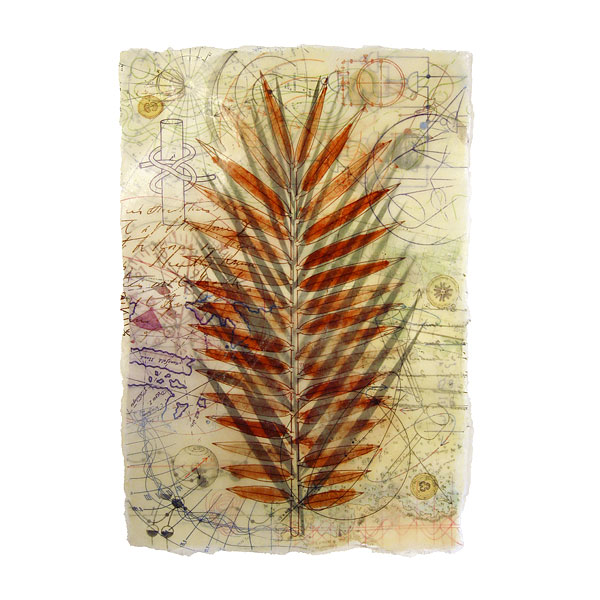
Red Palm, 2004
Copy transfers, other media and encaustic on sheets of Japanese
hand-made paper made translucent with wax and superimposed
over an armature grid of laminated basswood.
20 x 13.75 in. (51 x 35 cm)
Above is a piece comprised of 2 layers of Japanese plant paper with transfers, waxed
to transparency
so that elements on the sheet behind show through the front sheet.
I was looking for a way to emphasize the transparency of the front sheet more and to play with areas of opacity and transparency. I wanted a sculptural, structural element of some kind showing through.
I thought about a geometric grid but that seemed too rigid. I wanted something irregular.
Then I remembered 'stick charts', semi-ritualistic navigation charts used by the islanders
in the
South Pacific in the Marshall Islands. Made from the midribs of coconut fronds tied together to form an open frameworkin a flat arrangement. The charts represented major ocean swell patterns
and the ways the islands disrupted those patterns.
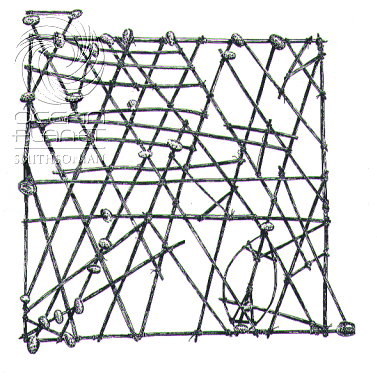
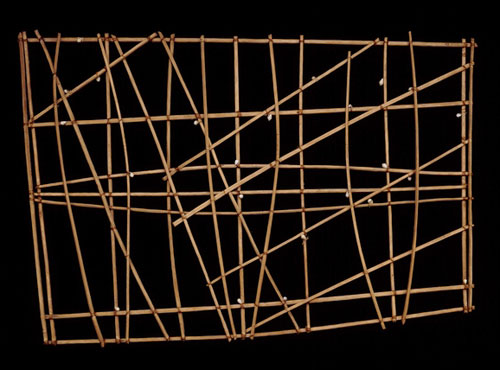
The use of these irregular grids not only provided the formal effect I wanted
but also another layer of meaning to play against the other elements of the piece.
So the combination of the stick chart with the transparent (or at least translucent)
front sheet looks like what you see below.Of course this image hardly conveys the effect
when you see the actual piece
as there is a whole dimensional quality to it.

Paraclete #16, 2006
Copy transfers, enamels and encaustic on Japanese plant papers
made translucent with wax over an armature grid of laminated basswood.
40.5 x 50.75x 2.5 in. (103 x 129 x 6.4 cm) - framed 52 x 62 x 4.5 in. (132 x 158 x 11.5 cm.)
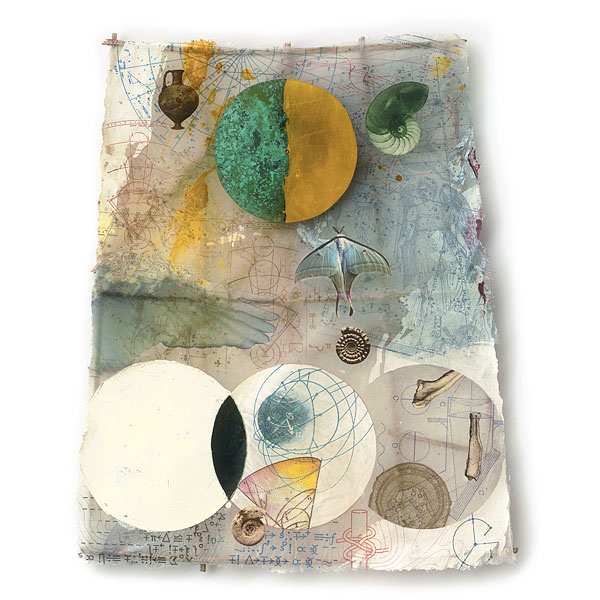
Selene #1 - 2009
Copy transfers, enamel, wax and other media on Japanese hand-made plant papers
made translucent with wax over an armature grid of laminated basswood
with attached object of copper.
22 x 19 x 1.5 in (56 x 48.3 x 4 cm)
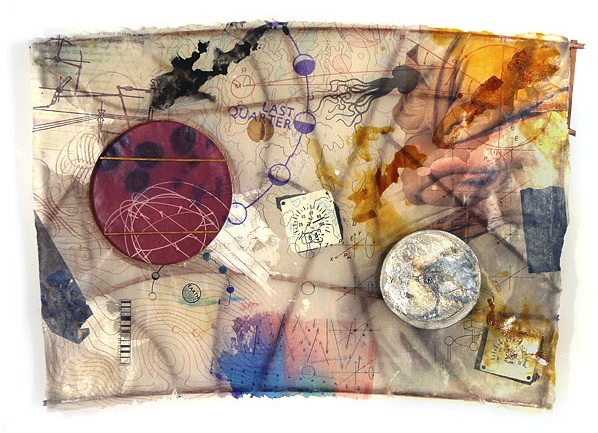
Qualia, 2010
Copy transfers, enamels and encaustic on Japanese plant papers
made translucent with wax over an armature grid of laminated basswood.
23 x 33 x 2 in. (58.5 x 83.8 x 5 cm)

Spray Above Enceladus, 2010
Copy transfers, other media and encaustic on sheets of Japanese hand-made paper
made translucent with wax superimposed over an armature grid of laminated basswood..
51.5 x 77 in. (130.8 x 195.6 cm)
I wanted to try a negative version of 'Selene' (see above).
That is to make a piece that would have the same elementsin the same position but in negative.
I wanted especially to make a piece that would be black or very dark yet would still b
translucent enough to let the stick chart show through from behind. I didn't succeed.
I was able to salvage the piece by moving the stick chart in front of the sheet.
The piece nonetheless sold quite quickly.
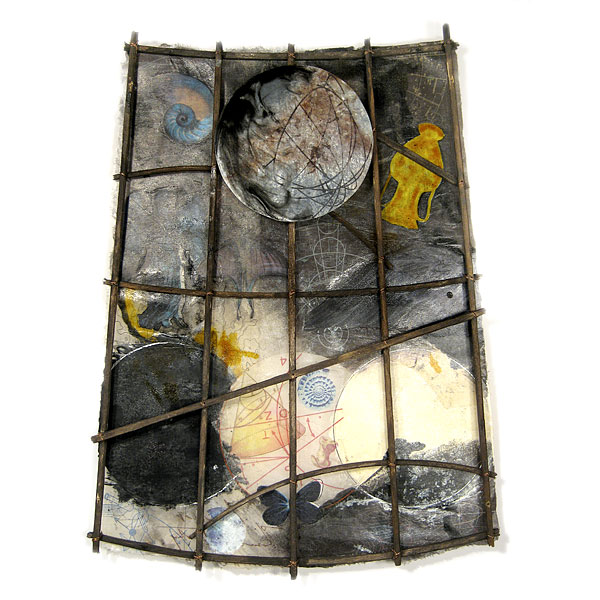
Gibbous Moon, 2010
Copy transfers, enamel, encaustic and other media
on hand-made Japanese paper and metal withbasswood and copper.
21 x 16 x 1.5 in. (54 x 40.5 x 3.5 cm)
Then the way to make it work occurred to me. By using the image of black feathers it would convey the idea of blackness very effectively but the stick chart would be able to show through in the gaps between the feathers. This resulted in 'Wraith #2. It does what I wanted it to by being 'black' while allowing the stick chart behind to be seen through the sheet.
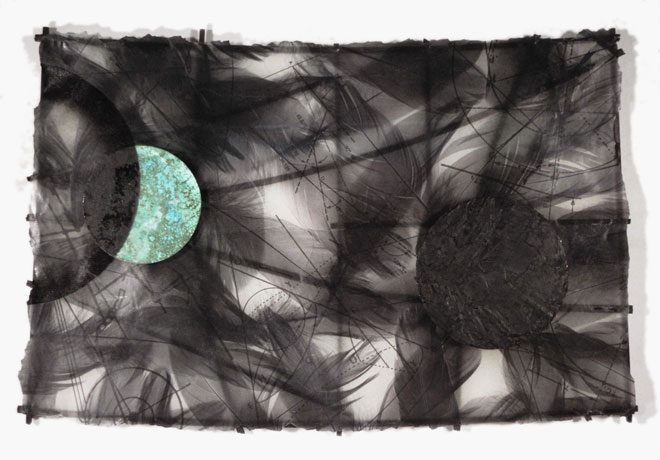
Wraith #2, 2012
Copy transfers and other media on Japanese plant paper made translucent with wax
with attached copper disk with encaustic and patination
over an armature grid of laminated basswood.
19.25 x 29 x 1.625 in. (49 x 73.7 x 4.3 cm.)
Then I was thinking one day about a friend, Michael McGee, who had commissioned a piece of my choosing, What kind of piece from among the tributaries of my work might he be interested in. I remembered how he had expressed a penchant for the Memory Thief image I had made for an album cover for the band Lost and Profound . But I wanted to go much further than to make another version of the same conceptual and symbolic territory. Then I thought about doing it as a stick chart piece. That would give the piece an extra dimension, literally. It would also create an fluctuation between a reading of the piece as a strictly pictorial piece of narrative and a more conceptual piece whose formal aspects are in play. I felt it would create a tension between those two modes of perceiving the work while adding
another symbolic element to it.
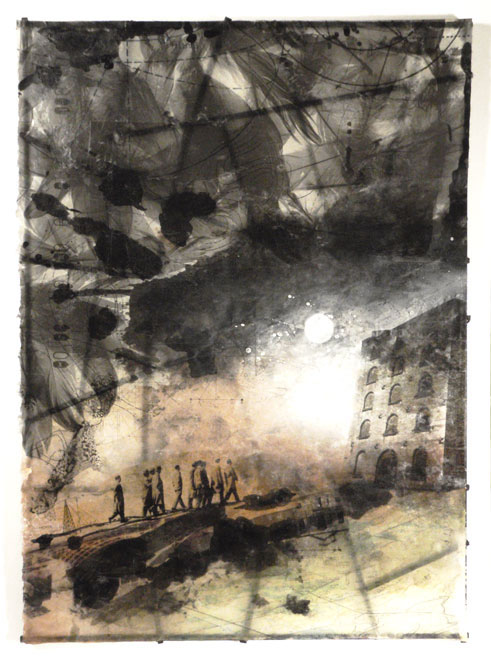
Memory Thief #2, 2012
Copy transfers and other media on Japanese plant paper made translucent with wax
over an armature grid of laminated basswood.
29.25 x 21.5 x 1 in. (74.3 x 54.7 x 2.54 cm.)
Here is the poster version of the original Memory Thief piece which was
done for the album cover of Memory Thief by a band called Lost and Profound
for Polygram Records.

Let me know what you think